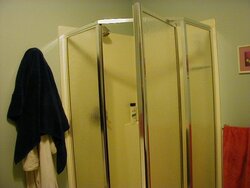Since Hearth is inhabited by a lot of people with active minds, skills, experience, and a willingness to help, let me pose this one to folks here:
I've done a fair amount of plumbing, and am usually pretty good at creative solutions or work-arounds, but maybe I have a brain cramp on this one- and I'm hoping someone else has solved this one or has an idea.
For background-- When I added an upstairs bathroom to my old farmhouse a few years back, I put in a fiberglass "corner shower" with glass door/ edge sides. Basically the glass door is at a 45 degree angle to the walls. It's a decent sized unit- not one of the tiny ones- but also not some monument-type thing you'd see in a McMansion. Showerhead & mounting arm are pretty ordinary- a non-exotic Moen showerhead and a chrome pipe with about a 45 degree bend. Shower valve allows control of both temperature and flow.
So here's the puzzle-
Like just about any shower, you have to let it run a bit for the hot water to make its way from the water heater to the shower. To do that, you of course have to open the door, since the control is in the shower. And the showerhead aims at the door-so, if the door is open and the water flow is turned on full tilt, it comes raining out the open door -- which is not a problem for me, since I temporarily turn the showerhead a bit to the side, and turn the water flow on only part-way.
The problem arises with (a) guests; and (b) my son, who is old enough to shower, but not old enough to reach the showerhead like I do to temporarily turn it to the side for the warm-up phase.
There must be a lot of corner showers in the world, and the designers and users presumably don't want water raining out the open door as one opens and closes it to get the water up to temp, and then again to step in. My bathroom floor is wide spruce planks (original to the house) with a clear epoxy marine grade varnish on top, so it won't be phased at all by the occasional water spatter- but on the other hand, the floor, or the ceiling below, are not going to do well if there's a regular shower occurring outside the door as well as inside.
Suggestions welcomed! Thanks
I've done a fair amount of plumbing, and am usually pretty good at creative solutions or work-arounds, but maybe I have a brain cramp on this one- and I'm hoping someone else has solved this one or has an idea.
For background-- When I added an upstairs bathroom to my old farmhouse a few years back, I put in a fiberglass "corner shower" with glass door/ edge sides. Basically the glass door is at a 45 degree angle to the walls. It's a decent sized unit- not one of the tiny ones- but also not some monument-type thing you'd see in a McMansion. Showerhead & mounting arm are pretty ordinary- a non-exotic Moen showerhead and a chrome pipe with about a 45 degree bend. Shower valve allows control of both temperature and flow.
So here's the puzzle-
Like just about any shower, you have to let it run a bit for the hot water to make its way from the water heater to the shower. To do that, you of course have to open the door, since the control is in the shower. And the showerhead aims at the door-so, if the door is open and the water flow is turned on full tilt, it comes raining out the open door -- which is not a problem for me, since I temporarily turn the showerhead a bit to the side, and turn the water flow on only part-way.
The problem arises with (a) guests; and (b) my son, who is old enough to shower, but not old enough to reach the showerhead like I do to temporarily turn it to the side for the warm-up phase.
There must be a lot of corner showers in the world, and the designers and users presumably don't want water raining out the open door as one opens and closes it to get the water up to temp, and then again to step in. My bathroom floor is wide spruce planks (original to the house) with a clear epoxy marine grade varnish on top, so it won't be phased at all by the occasional water spatter- but on the other hand, the floor, or the ceiling below, are not going to do well if there's a regular shower occurring outside the door as well as inside.
Suggestions welcomed! Thanks


